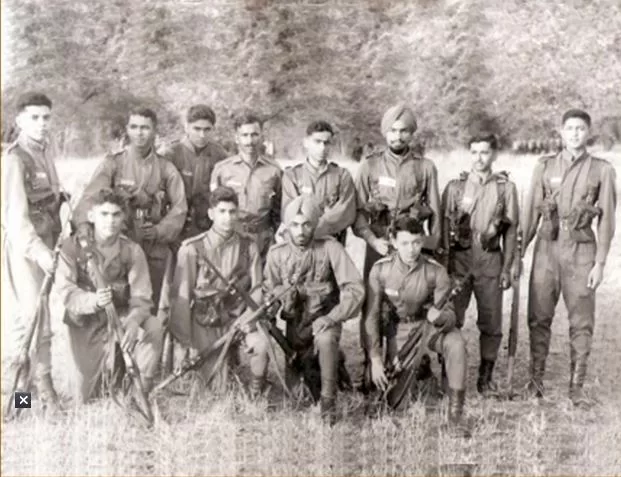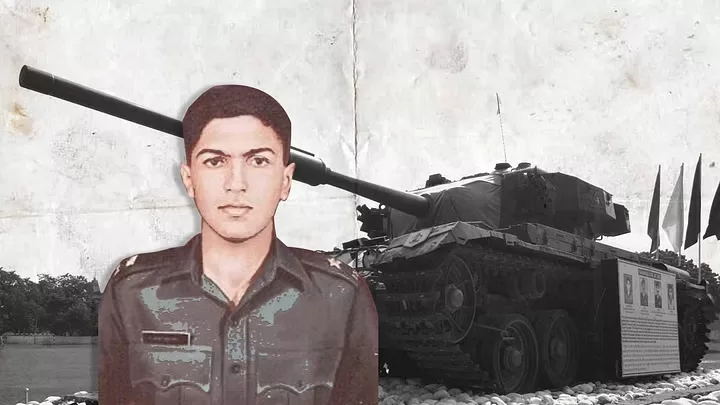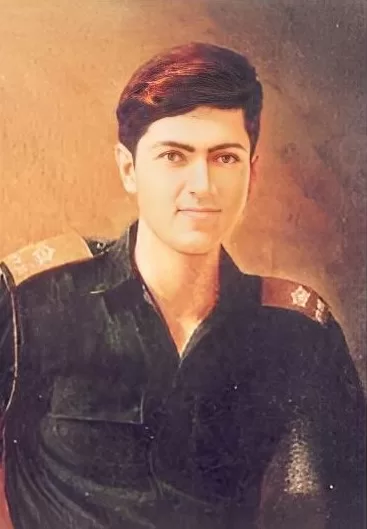Poona Horse is an armored regiment of Indian army with traditions going back two centuries. In Anglo-Persian war of 1856-57, Poona Horse captured the standard of 1st Khushgai Regiment at the battle of Khushab. A silver hand surmounted the standard and palm was engraved with Arabic words of ‘Yad Allah fawquar aydihim’ (the hand of God is above all things). Poona Horse was allowed to bear this standard and silver hand became part of regimental insignia.
After First World War, there was large scale demobilization of Indian army. In 1922-23, Indian army went through major reorganization. Several cavalry regiments were amalgamated and 33rd Queen Victoria’s Own (QVO) Cavalry and 34th Prince Albert Victor’s Own (PAVO) Cavalry were amalgamated to form 17 Poona Horse. 33rd Bombay Cavalry originated as 3rd Bombay Light Cavalry and at the time of amalgamation had four squadrons; A Jat Squadron (mainly from Rohtak area), B Kaim Khani, C Muslim Rajput and D Sikh squadron. 34th Cavalry originated as Poona Auxiliary Horse in early 1800s. Class composition of squadrons at the time of amalgamation was A and B Rathore Rajputs (mainly from Jodhpur), C Punjabi Muslim (mainly from Jehlum area) and D Kaim Khani squadron (mainly from Shekhawati region of Jaipur). Amalgamation was done in Jhansi and Risaldar Major (RM) Hamir Singh; winner of Indian Distinguished Service Medal (IDSM) became the first RM of 17 Poona Horse. Rathore Rajputs of 34th Cavalry, Jats of 33rd Cavalry and Kaim Khanis from both 33rd and 34th Cavalry (half squadron from each regiment) made it to 17 Poona Horse and final class composition of the new regiment was A Rathore Rajput, B Kaim Khani and C Jat squadron. Headquarter squadron was mixed. Remaining soldiers were sent to other regiments or cashiered.
17 Poona Horse has the honor of having the first Indian King Commissioned Officer (KCO) among its ranks. The first Indian graduate from Sandhurst Syed Iskander Ali Mirza was commissioned on July 16, 1920. Officers destined for Indian army spent their first year with a British battalion. Mirza was posted to Second Battalion of Scottish Rifles (Cameroonians). He was the first Indian officer to serve with British on equal basis and this caused uproar in some circles. This issue caused a prolonged struggle involving Indian army brass, Viceroy’s Army Council, War Office in London and Secretary of State of India. This dragged on for six months and finally Mirza was able to join Scottish Rifles in January 1921. Battalion was stationed at Kohat and commanded by Lieutenant Colonel Oakley. After a year with Scottish Rifles, Mirza joined his parent 33rd Cavalry Regiment stationed at Jhansi. Around the same time reorganization of Indian army was under way and 33rd Cavalry and 34th Cavalry were in the process of amalgamation to form 17 Poona Horse. He was posted to B Kaim Khani squadron. Regimental record states that Mirza was very popular among ranks. In 1924, 17 Horse left for frontier duty at Bannu and later spent several years in Peshawar. Mirza remained with his regiment for four years and transferred to Indian Political Service (IPS) in August 1926. He was Captain when he resigned his commission.
In his long career at IPS, Mirza served in Bannu, Hazara, Tank and Peshawar. He also served as Political Agent of Khyber and Mohmand tribal agencies. After two decades long career on North West Frontier, he was appointed Political Agent to Orissa states and then went to Delhi as joint secretary defense. He became Secretary Defense in newly independent state of Pakistan. Later, he became Governor General and President of Pakistan. In October 1958, General Muhammad Ayub Khan exiled Mirza to London after the coup. He lived in a poor financial state but with dignity. His political decisions have been rightly criticized by many. However, he was the gentleman of the old school scrupulously honest in financial matters. He had served at the highest positions of government service but had no assets. He died in 1969 in London and was buried in Tehran where he was honored with a state funeral. His total assets were £ 859.08 and after paying £ 476.47 for solicitor’s fee and other expenses a grand total of £165.74 was distributed to six family members. Quite a contrast when we compare it with the later generation of government servants and politicians of India and Pakistan who have allegedly siphoned off billions of dollars of public money to their personal accounts in foreign banks.
One of the legendry Viceroy Commissioned Officer (VCO) of 17 Poona Horse was Risaldar Major Anno Khan. Anno Khan was a Kaim Khani and joined 34th Cavalry in 1907. In Great War, he won Indian Distinguished Service Medal (IDSM) in France. He rose through the ranks and appointed Risaldar Major in 1932. Queen Victoria started the tradition of having Indian VCOs as her orderly officers and a group of VCOs would spend few months in England as orderly officers to the sovereign. In 1933 RM Anno Khan was appointed Orderly Officer to King George V. In Royal functions, it was a treat to see King’s Indian orderly officers standing behind him in full regimental uniforms and Anno cut a dashing figure. He retired in 1936 but family connections with the regiment continued and his two sons followed their father’s footsteps and served with 17 Horse. In addition to Anno Khan, two other VCOs RM Hamir Singh and RM Zalim Singh were some of the best that Indian army produced and all of them proudly called 17 Poona Horse their home.

17 Poona Horse was one of last Indian cavalry regiment to say goodbye to their horses in January 1941. In 1947, Indian army was divided between two successor states of India and Pakistan. Most regiments had class squadrons therefore class squadrons were exchanged between regiments. 17 Poona Horse was allotted to India. In 1947, regiment was in Risalpur. Jat and Rajput squadrons would naturally go to India. Kaim Khanis were Muslims but they belonged to Rajputana states (some were settled in Indian part of Punjab) that had become part of India. Kaim Khanis opted for India and whole regiment left Risalpur for India. Kaim Khanis seeing all the carnage on their way to India later had second thoughts. Regimental officers and soldiers reassured them and even arranged for trips to their villages to Rajputana to asses the situation. Kaim Khanis changed their decision and decided to opt for Pakistan leaving their ancestral lands. 13 Lancers was allotted to Pakistan and Sikh squadron of 13 Lancers was allotted to 17 Poona Horse. Later, when Kaim Khani squadron of 17 Poona Horse came to Pakistan, it was allotted to 19 Lancers.
Partition had divided families between two countries and that affected 17 Poona Horse. RM Anno Khan now retired decided to stay in India in his village. His one son Yunus Khan also stayed in India, serving with 17 Poona Horse and retired as Risaldar. Anno’s other son Mehboob Khan had also served with 17 Horse and retired as Daffadar. In 1947, Mehboob decided to come to Pakistan. Mehboob’s son Shamshad Ahmad joined Pakistan army. In 1965 war, he was serving with 25th Cavalry of Pakistan army and his regiment fought against 17 Horse; his family regiment. If Mehboob had decided to stay in India, it was very likely that his son Shamshad would have joined his family regiment and fighting against 25th Cavalry.
A large number of Kaim Khanis migrated to Pakistan in 1947. Iskander Mirza then serving as Secretary Defense had served with the Kaim Khani squadron of 17 Poona Horse. He helped to settle Kaim Khanis in Sindh and Punjab. Anno Khan made a trip to Pakistan and met Iskander Mirza. Both men surely would have recounted nostalgic memories about the days when a young and dashing lieutenant recently out of Sandhurst made his acquaintance with a wise VCO. Iskander asked him to stay back in Pakistan and offered land but Anno declined and returned to India.
In 1965 India-Pakistan war, 17 Poona Horse commanded by Lieutenant Colonel Ardeshir Burzorji Tarapore (nick named Adi) fought against 25th Cavalry commanded by Lieutenant Colonel Muhammad Nisar (later Brigadier) of Pakistan army. Commanding officers of both regiments were originally from state forces and not regular Indian army. Adi had joined Hyderabad State Forces first serving with 7th Hyderabad Infantry and later Ist Hyderabad Lancers. After 1947, he switched to Indian army and joined Poona Horse. Nisar was originally from Patiala State Forces. He opted for Pakistan and joined 5th Probyn’s Horse. Later, he raised and commanded 25th Cavalry. Adi was killed in action and awarded highest Indian military award for gallantry Param Vir Chakra (PVC). Both regiments have great respect for the opposing Commanding Officer considering them outstanding and thoroughly professional officers who gave the best performance.
In 1971, India-Pakistan war, 17 Poona Horse commanded by Lieutenant Colonel Hanut Singh (later Lieutenant General) fought against 13 Lancers of Pakistan army commanded by Lieutenant Colonel Syed Masud Ahmed. Both regiments had a bond going back to early 1940s. In 1943, 13 Lancer helped 17 Poona Horse during its conversion to an armored car regiment. In 1947, when Indian army was divided, Sikh squadron of 13 Lancers was allotted to 17 Poona Horse. At the time of partition, 17 Poona Horse was in Risalpur and 13 Lancers in Secunderabad. Poona Horse left its tanks and equipment at Risalpur for the incoming 13 Lancers. Now, twenty four years later, 13 Lancers that had inherited tanks and equipment of 17 Poona Horse was confronting the same regiment in the battlefield.
Second Lieutenant Arun Khetrapal of 17 Poona Horse belonged to a military family of Sargodha and ironically born in Poona where his father was then posted. Arun came to the battlefield with only five months of military service. 17 Horse and 13 Lancers were engaged in a heavy firefight on western front. At one point, Arun’s tank came face to face with the Pakistani squadron commander’s tank. A shot fired by Pakistani tank went through the turret of Arun’s tank killing him. Arun was posthumously awarded India’s highest gallantry award of Param Vir Chakra (PVC).
In 2001, Arun’s father retired Brigadier M.L. Khetarpal (Engineers) came to Pakistan to visit his ancestral village in Sargodha. Khetarpal’s host in Lahore was retired Brigadier Khawaja Muhammad Nasir and his family. Nasir and his family went out of their way to make Khetarpal’s stay comfortable. Nasir arranged for the nostalgic visit of Khetarpal to his ancestral home in Sargodha.

On the final night of stay of Khetarpal, Nasir told him that he was the squadron commander of 13 Lancer in 1971 and Arun died in a firefight with his tank. Nasir said ‘Sir there is something that I wanted to tell you for many years but I did not know how to get through to you. Finally fate has intervened and sent you to me as an honoured guest. The last few days we have become close to one another and that has made my task even more difficult. It is regarding your son who is of course a national hero in India. However on that fateful day, your son and I were soldiers, unknown to one another, fighting for the respect and safety of our respective countries. I regret to tell you that your son died in my hands. Arun’s courage was exemplary and he moved his tank with fearless courage and daring, totally unconcerned about his safety. Tank casualties were very high till finally there were just two of us left facing one another. We both fired simultaneously. It was destined that I was to live and he was to die”. Nasir added that “I had all along thought that I would ask your forgiveness, but in telling the story I realize that there is nothing to forgive. Instead I salute your son for what he did at such a young age and I salute you too, because I know how he grew into such a young man. In the end it is character and values that matter.”
Arun’s mother Maheshwari Khetarpal remembered that Nasir had told her husband that “Arun fought like a tiger and we went to see him after his death. He said Arun was truly a tiger, a brave soldier.” Khetarpal and Nasir were both soldiers and understood the cruelty of war but had respect for each other. Khetarpal called Nasir a ‘hero of Pakistan’ and Nasir praised Arun stating that ‘he was a very brave boy’ and was “singularly responsible for our failure that day”. On the last day of the visit, photographs were taken and Brigadier Khetarpal returned back to Delhi. Later the photos reached Delhi along with the following note from Brigadier Nasir:
“With Warmest regards and utmost sincerity, To: Brigadier M.L. Khetarpal, father of Shaheed Second Lieutenant Arun Khetarpal, PVC, who stood like an unsurmountable rock, between the victory and failure, of the counter attack by the ‘SPEARHEADS’ 13 LANCERS on 16 December 1971 in the battle of “Bara Pind’ as we call it and battle of “Basantar’ as 17 Poona Horse remembers. Khawja Mohammad Naser, 13 Lancers 02 March 2001 Lahore, Pakistan”
Indian and Pakistani armies have produced many fine officers and gentlemen who upheld the finest traditions of the profession. The journey started in British Indian army as brothers in arm but after independence they got entangled in conflict over Kashmir. Many even in the carnage of war maintained their humanity and professionalism. Both armies can be proud of such officers and these traditions need to be carried on by the future generation of officers.
Acknowledgements
Special thanks to Major ® Shamshad Ahmad; grandson of Risaldar Major Anno Khan for providing valuable information during an interview with the author in 2012 and Major ® Agha H. Amin for providing details about Muslim Rajputs, Ranghars and Kaim Khanis and their recruitment in Indian army.
Notes
Regimental History of Poona Horse, a copy is available on online at Poona Horse Regimental Association, http://web.archive.org/web/20040722123932/http://poonahorse.com/history.htm and http://www.bharat-rakshak.com/LAND-FORCES/images/Poona%20Horse.pdf
Lt. Colonel ® Gautam Sharma. Nationalization of the Indian Army 1885-1947 (New Delhi: Allied Publishers Limited, 1996)
Humayun Mirza. From Plassey to Pakistan: The Family History of Iskandar Mirza (Lahore: Ferozsons, 2000, Pakistan Edition)
Hamid Hussain. Indian Army Officer Corps – Social Panorama. Defence Journal, August 2011
Ashok Nath. Re-Forging The Damascus Blade – Partition of the Indian Armored Corps, 1947 in Alan Jeffreys & Patrick Rose (Ed.) The Indian Army, 1939-47: Experience and Development (Surrey: Ashgate Publishing Limited), 2012
Major General ® Shaukat Riza. The Pakistan Army 1947-1949 (Lahore: WAJIDALIS), 1989
http://www.hindustantimes.com/News-Feed/ColumnsOthers/An-officer-and-a-gentleman/Article1-733331.aspx
http://www.ndtv.com/article/india/sent-son-to-war-got-back-a-param-vir-chakra-73123




